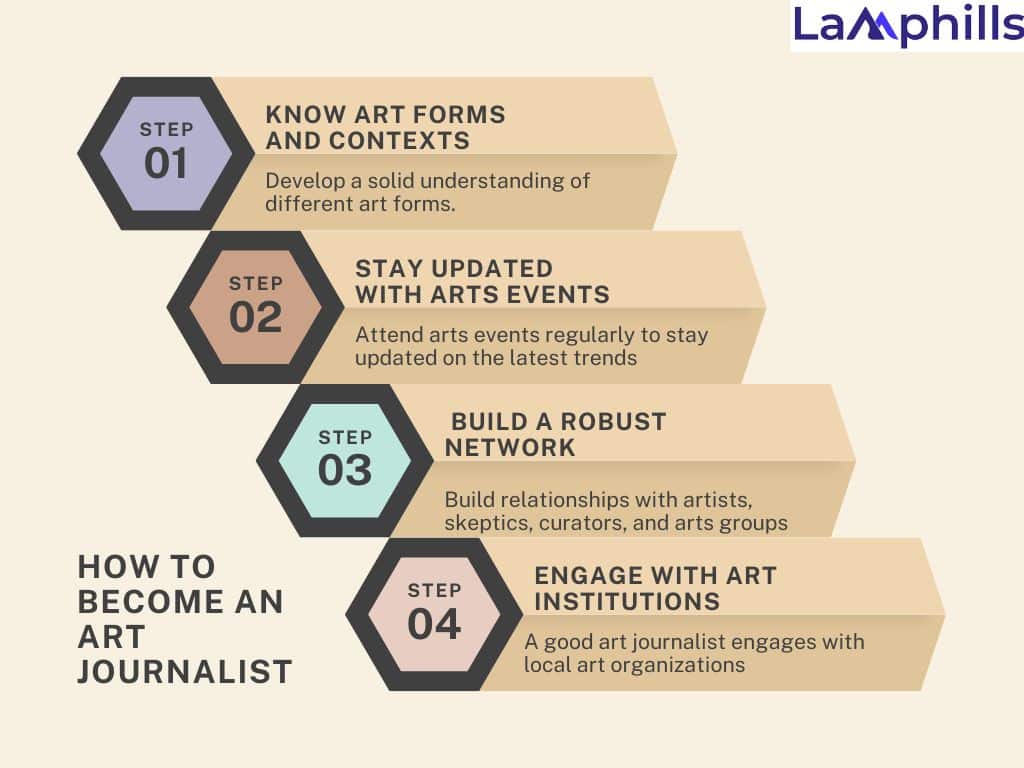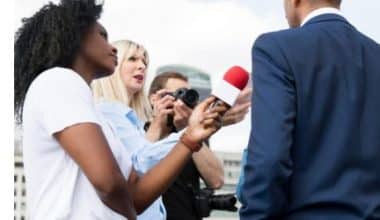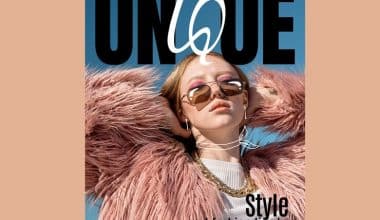Art journalism is a dedicated field that specializes in visual arts, which includes painting, sculpture, photography, and other forms of creative expression. It covers various topics, from major art exhibitions to the latest updates in modern art. Art can inspire creativity and break through barriers. When done well, arts journalism may be just as successful. This trend is significant because it indicates a possible lack of awareness of the transforming power of art in our society. There is no need to rush into details yet! Do you want to know more about art journalism, top art Journalists & how to become one. Then this article is for you. Read on!
Key Points
- Art Journalists write for different publications, including newspapers, magazines, and websites.
- To be a successful art journalist, one must cultivate a comprehensive knowledge of different art forms, their historical backgrounds, and their cultural significance. This basic knowledge equips journalists to write interesting and engaging articles that align with readers.
- Effective storytelling is a key skill for art journalists. By developing their ability to tell the intellectual and emotional impact of art, journalists can create captivating and accessible articles. Using descriptive language and engaging narratives helps convey the beauty and significance of art to a broad audience.
- Keeping up-to-date with arts events is important for any art journalist. Regular attendance at exhibitions, galleries, and other art-related events ensures that journalists stay informed about current trends, new artists, and significant developments in the arts community. This continuous engagement allows them to produce timely and relevant content.
Art Journalist
It is possible to become a journalist at any stage of your career.
Journalists have an important role in keeping the public informed. These reporters assess current events and present essential stories at the local, national, and global levels.
In this context, who is an art journalist?
An art journalist is an individual whose interests are particularly in the world of art. They are prolific writers who focus on topics such as paintings, sculpture, photography, and many other forms of artistic expressions.”
Furthermore, they help the public and viewers understand, appreciate, and discover the beauty and meaning of art by sharing stories, ideas, and opinions in a manner that is interesting, engaging, and easy to understand.
Art journalists are often experts in their field, with a deep understanding of the history, techniques, and trends in the art world. They may work for newspapers, magazines, websites, or other media outlets, and often travel to galleries, museums, and exhibitions around the world to see and report on the latest artworks and events.
In short, an art journalist’s job is to bring the world of art to life through their writing, inspiring readers to explore and connect with the creative expressions of artists from different cultures and eras.
How to Become an Art Journalist

Art journalism is interesting. It serves as a bridge between an originator and his audience. Further, it acts as an opening into the world of culture, histories, and personalized experiences that may otherwise remain untouched.
Documenting, analyzing, and interpreting artistic expression, arts reporting helps preserve cultural history and adds to the perception of how creativity changes our world
To get you started on your arts reporting journey, I have provided some entry points and story ideas to help you enrich what you report. To become an art journalist, you need to
#1. Master Different Art Forms and Their Contexts
As an aspiring art journalist ready to venture into the broad world of art journalism, have you ever thought about mastery of art forms, and what they portray? Indeed, they give you the upper hand as you go about your art career. Develop a solid understanding of different art forms, their historical context, and their significance within culture.
Read also: How to Become a Journalist Even Without Experience: An Insider’s Guide
#2. Stay Updated with Arts Events
Attend arts events regularly to stay updated on the latest trends, new artists, and significant developments within the arts community. Additionally, always stay abreast with art trends through media outlets, press releases, websites, periodicals, and so on.
#3. Build a Robust Network in the Arts Community
Build relationships with artists, skeptics, curators, and arts groups to build a strong network and gain access to exclusive stories and opportunities.
#4. Engage with Local Art Institutions

To be an excellent art journalist, you must engage with local art organizations such as galleries, museums, and cultural centers. This allows you as a journalist to develop relationships with curators, artists, and other industry professionals who can provide vital insights and access to exclusive events and exhibitions.
Engaging with local art institutions also helps journalists stay up to date on the newest trends and changes in the art world, which is crucial in delivering relevant and timely content. Attending events and exhibitions at these organizations can also inspire fresh story ideas and provide possibilities for in-depth reporting on emerging and known artists, as well as the cultural and socioeconomic themes reflected in their work.
#5. Conduct Thorough Research
Conduct thorough research to understand the origin and background of the art you are covering, enabling you to provide informed and insightful reporting.
#6. Study Influential Artists
To be a good art journalist, you must first understand the work and backgrounds of famous artists. Understanding their artistic experiences, approaches, and impact on the local art scene adds vital context to your writing. This understanding can help you write more engaging and insightful articles, connecting your readers to the artists’ experiences and opinions.
Studying influential artists can also help you generate new narrative ideas and spot rising trends and themes in the art industry.
#7. Hone Storytelling Skills
Strong storytelling skills are a must for art journalists to have to communicate to their audience the intellectual and emotional power of art. Writing ought to be as complicated as art, which is a powerful tool for evoking different kinds of feelings and ideas.
#8. Collaborate with Visual Storytellers
Collaborate with photographers, videographers, and graphic designers to enhance the visual appeal of your reporting, allowing readers to experience the art through multimedia elements.
I once had the opportunity to interview a notable journalist in my locality and this was how he started. Take note of the highlighted words and sentences.
An Interview Between I and Mr. X
Interviewer (I): Welcome! Thank you for joining us today. Can you start by telling us how you became an art journalist?
Journalist: Thank you for having me! It all started back in college when I was studying art history. I was always passionate about art, but I realized that I wanted to do more than just study it—I wanted to share it with others. So, I started writing for the university newspaper, covering local art events and exhibitions.
Interviewer: That sounds like a great beginning. What happened next?
Art Journalist: After graduation, I continued to write articles and reviews for various online platforms. I knew I needed to build a portfolio, so I took every opportunity I could find. At first, it was challenging because I was balancing freelance writing with a full-time job. But I was determined, and I made sure to attend as many art events as possible, always looking for unique stories to tell.
Interviewer: It must have been a busy time for you. How did you manage to break into the industry?
Journalist: One day, I decided to pitch an article to a well-known art magazine. It was a piece about an emerging artist who was making waves in the local scene. To my surprise, they loved it and published it. That article opened many doors for me. I started getting more assignments from established publications and my network began to grow.
Interviewer: That’s impressive! What kept you motivated during the tough times?
Journalist: Honestly, it was my love for art and storytelling. Each piece of art has a story behind it, and I wanted to be the one to tell those stories. Likewise, seeing my work published and receiving feedback from readers was incredibly rewarding. It reassured me that I was on the right path.
Interviewer: How did you develop your unique voice as an art journalist?
Journalist: It took time and practice. I read a lot of work by other art journalists and critics to understand different styles. But ultimately, I found that being authentic and passionate about the subjects I was writing about helped me develop my own voice. I focused on being informative yet engaging, always aiming to connect with my audience.
Interviewer: What advice would you give to aspiring art journalists?
Journalist: I would say, don’t be afraid to start small. Write for local publications, blogs, or even start your own blog. Attend art events, network with artists and other writers, and always keep learning. Stay learning and passionate about art, and let that passion shine through in your writing. It’s a journey, but if you stay dedicated, you’ll find your place in the industry.
Interviewer: Thank you so much for sharing your story. It’s truly inspiring!
Journalist: Thank you for having me! It’s been a pleasure to share my journey.
Art Journalist Jobs
#1. Culture and Entertainment Reporter
This job focuses on expanding the audience through engaging coverage in the country’s fastest-growing areas (culture or entertainment precisely).
A must read: Everything You Should Know About Entertainment Journalism
You will write quick-hit entertainment and culture news, lists, and food features about issues, events, and local talent. Your work will also include creating guide-like content for the readers.
In addition to short reports and in-depth pieces, you’ll produce quick-form video reports to enhance digital presence and mobile-first storytelling for social media and our website.
#2. Art Critic/Curator
As an art critic, your principal role is to study, interpret, and assess art exhibitions, galleries, and specific works of art for print and internet media. This involves:
- Attending art exhibitions and activities. Regularly visiting galleries, museums, and other art venues to keep up with current art trends and discover new artists.
- Researching artists and their works: To contextualize your critiques, research artists’ origins, approaches, and creative processes.
- Writing an entertaining and informative review: Creating well-written, intelligent, and interesting critiques that communicate your researched viewpoints on the artworks and exhibitions you cover.
- Gaining a thorough understanding of art history and theory: Acquiring a thorough understanding of diverse art trends, styles, and approaches to aid your analyses and reviews.
#3. Art Editors
Art editors are basically concerned with the sole task of leading and managing a dedicated team of writers to provide entertaining, insightful, and well-crafted content for publication. This includes
- Managing the editorial process and overseeing the entire content generation procedure, which includes assigning stories to writers, revising their work, and ensuring that all content fits your publication’s standards and requirements.
- Curating content and deciding which art-related subjects, events, and artists to feature in newspapers, taking into account accuracy, validity, and audience interest.
- Ensuring accuracy and quality which further entails fact-checking articles, verifying sources, and ensuring that all content is thoroughly researched, accurate, and well-written.
#4. Staff Writers
A staff writer is a full-time journalist who reports on art-related events, exhibitions, and trends for a media organization. They are in charge of writing entertaining, well-researched, and informative articles that keep readers up to date on the current events and trends in the art world.
See: The Secret Vertical Marketing System for Hyper-Focused Growth
Top Art Journalists
Let’s take a look at some of the top journalists and reporters covering art, whose contact (Twitter, most especially) details you can see linked to their names.
#1. Sarah Douglas, Editor-in-Chief at ARTnews
Sarah Douglas began her career as an art writer and editor in 1999. From April 2011 to July 2014, she worked as Culture Editor for The New York Observer. In the fall of 2011, she founded GalleristNY, The New York Observer’s visual arts website, which she handles. She also contributes to The Art Newspaper’s daily editions covering Frieze, Art Basel, and Art Basel Miami Beach. Douglas previously worked as a staff writer at Art+Auction, Modern Painters, and Artinfo.com, where she was a major member of the site’s founding editorial team when it launched in April 2005.
For four years, she oversaw the U.S. editorial office of the London-based The Art Newspaper and has contributed to T: The New York. Times Style Magazine, New York magazine online, The Economist’s quarterly Intelligent Life and The National, among others.
#2. Patricia Bickers, Editor, Art Monthly Magazine
Image Credit: Artland Magazine
Patricia Bickers is editor of Art Monthly and principal lecturer in art history and theory at the University of Westminster. She is the author of The Brit Pack: Contemporary British Art, The View from Abroad (Cornerhouse, 1995), and recently co-edited, Talking Art: Interviews with Artists since 1976, (Art Monthly and Ridinghouse Editions, 2007).
She has spoken extensively about public relations and art journalism and should be on your press list if you are interested in global contemporary art.
#3. Jonathan Jones, Prolific Writer at The Guardian

Born: 1976 (age 48 years), Wales, United Kingdom
Jonathan Jones is a British art critic who has written for The Guardian since 1999. He has appeared in the BBC television series Private Life of a Masterpiece and in 2009 was a judge for the Turner Prize. He has also been a judge for the BP Portrait Award.
What Does an Art Journalist Do?
An art journalist is an individual whose interests are particularly in the art world. They are prolific writers who focus on paintings, sculpture, photography, and many other forms of artistic expression.”
What Does an Art Writer Do?
An art writer is very synonymous with an art journalist.
That is to say, the two terms can be used interchangeably.
Arts writers write about many topics: they review contemporary art exhibitions, current events in the art world, and more.
Is Journalism an Art Subject?
Some tertiary institutions offer BA (arts) and BS (science) degrees in Journalism. Curators often select the BA. Conversely, producers and production experts frequently go for the BS option.
Is Journalism art or Business?
Journalism is art!
Why do I say so?
The art of storytelling requires talent and a deep understanding of all the elements needed to create a captivating story.
The Bottom Line
Art journalism is a challenging but rewarding field. If you’re passionate about art and you have a knack for writing, then a career in art journalism could be a great fit for you. Likewise, if you, however, follow the tips that I dished out in this article, you are surely on your way to stardom in the art world!
Related Posts
- What Journalists Want in a Media Advisory (And What to Avoid) + Free Templates
- Building an Effective Media List: How To Research & Target the Right Journalists for Your Story
- Key Roles of Public Relations In Marketing






